
 Written, directed and produced by some guy named David Schwartz, Las Vegas Blood Bath is a homemade horror film shot on video and so thoroughly, gloriously incompetent that it’s best enjoyed as a rollicking comedy. Camcorder sound, sub-amateur actors, zero sense of pacing, nonexistent editing: It’s all here, folks!
Written, directed and produced by some guy named David Schwartz, Las Vegas Blood Bath is a homemade horror film shot on video and so thoroughly, gloriously incompetent that it’s best enjoyed as a rollicking comedy. Camcorder sound, sub-amateur actors, zero sense of pacing, nonexistent editing: It’s all here, folks!
Ari Levin stars as an average Joe named Sam. He looks like Jerry Seinfeld, but has the charisma of Jason Alexander; he’s so remarkably inept as an actor, he’s ineptly remarkable. He’s just closed the business deal of his life when he decides to buy his wife, Ruthie, that little red sports car she’s been wanting and drive it back home to Vegas to “surprise the hell out of her.” He keeps himself awake by singing songs to himself (“Ruthie, Ruthie / You’re so pretty”), but when he arrives, he finds that he’s the one surprised. You see, Ruthie — some skank in a blonde Elvira wig — is sleeping with a naked cop. Sam snaps, shoots them both and goes tooling around town with Ruthie’s disembodied head in tow.
 “All women are the same! They all deserve to die!” Sam screams, which is all the movie allows in way of motivation and plot. Still clad in tie and slacks, he’s going to exact his revenge on the female species, one slut at a time … in broad daylight along highly trafficked areas. Said plan begins when he spots a hooker (“There’s one!”) and picks her up. Some guy drives by and flips them off; she wonders why. “Oh, I don’t know,” he bellows bitterly, “maybe he doesn’t like daytime whores!”
“All women are the same! They all deserve to die!” Sam screams, which is all the movie allows in way of motivation and plot. Still clad in tie and slacks, he’s going to exact his revenge on the female species, one slut at a time … in broad daylight along highly trafficked areas. Said plan begins when he spots a hooker (“There’s one!”) and picks her up. Some guy drives by and flips them off; she wonders why. “Oh, I don’t know,” he bellows bitterly, “maybe he doesn’t like daytime whores!”
Following the lengthiest driving sequence in which the audience is spared no left turn, Sam takes Daytime Whore to an apartment complex parking lot, where he ties her up, pulls off her top, introduces her to Ruthie’s head, stabs her through the chin and yanks off her leg with his car. No one seems to notice the bloody limb being dragged from the back bumper — this is Vegas, after all, and as the ads say, whatever happens here, stays here.
From there, it’s off to shoot a bartender in the head and — yes! — more driving. Another guy pulls up alongside Sam to give him the bird, but this time Sam responds by shooting off the man’s middle finger, demonstrating impeccable precision aim for such a nerdy salesman homebody.
 His thirst for blood finally takes him to a home of one of the Beautiful Ladies of Oil Wrestling (that’s B.L.O.W. for short; subtle, this film is not), where the not-at-all-beautiful, not-true-ladies have gathered this night to scarf down sausage pizza and watch themselves on TV. But first, the frizzy haired girls — christened with monikers like Bambi, Cherry Blossom and Tuff Tiff — all try on bikinis that the most horse-faced of the bunch brought back from New York, because apparently, in a town where prostitution and gambling are perfectly legal, garish swimwear must not be.
His thirst for blood finally takes him to a home of one of the Beautiful Ladies of Oil Wrestling (that’s B.L.O.W. for short; subtle, this film is not), where the not-at-all-beautiful, not-true-ladies have gathered this night to scarf down sausage pizza and watch themselves on TV. But first, the frizzy haired girls — christened with monikers like Bambi, Cherry Blossom and Tuff Tiff — all try on bikinis that the most horse-faced of the bunch brought back from New York, because apparently, in a town where prostitution and gambling are perfectly legal, garish swimwear must not be.
Even Barbara, the lone pregnant one of the group, models a bikini, much to the disgust of the other girls. “Someone should harpoon that whale,” snaps one after the expectant mother leaves the room. This prompts such a litany of anti-Barbara barbs that one half-expects the girls to say, “At least we terminate our pregnancies!”
 Finally, after offing a nosy neighbor with a shovel, Sam bursts in and has his way with each of the smoky chicks, and that means tying them up and drilling a head or pulling out an arm here and there. After tying up one of the girls in the bathtub, he asks what she does for a living. She responds meekly and with no sense of irony (or any semblance of emotion, really), “I’m a professional oil wrestler and also a TV star.” This sends him into a psychotic rage — “Ruthie loved oil wrestling!” — and he stabs her.
Finally, after offing a nosy neighbor with a shovel, Sam bursts in and has his way with each of the smoky chicks, and that means tying them up and drilling a head or pulling out an arm here and there. After tying up one of the girls in the bathtub, he asks what she does for a living. She responds meekly and with no sense of irony (or any semblance of emotion, really), “I’m a professional oil wrestler and also a TV star.” This sends him into a psychotic rage — “Ruthie loved oil wrestling!” — and he stabs her.
But the most pain to be inflicted Sam saves for the preggo Barbara. “C’mon,” he says, dragging her upstairs, “we’re going to play obstetrics and gynecology!” And he’s not joking. After he feels up her milk-engorged breasts and compliments her “dark silver dollars” (in a scene so humiliating, you hope the woman was handsomely paid, but know in your heart she was all too glad to do it for $20 and a corndog), he slices open her abdomen, retrieves the fetus and then hurls it against the wall! It’s all right, however, because the bedroom walls are conveniently adorned with butcher paper, should anyone ever break in and want to toss around an unborn child.
That’s the highlight of this Blood Bath, and really, where can a movie go from there? Oh, it tries its damndest, what with Sam decapitating a Jehovah’s Witness and dispatching a cop who looks like Freddie Mercury, but really — once you have a character engage in infant discus, everything else is just gravy. It’s in Syd Field’s screenwriting book. Look it up. —Rod Lott
Buy it at Amazon.

 When Jean-Claude Van Damme’s character says, “There is no end,” you’d be forgiven for thinking he could be referring to the Universal Soldier franchise, which numbers either four or six with the arrival of Universal Soldier: Day of Reckoning, depending on which nerd you ask. No end is necessary if the sequels were to stay at this entry’s level of quality — a tall order, to be sure, as director/co-writer John Hyams (2009’s Universal Soldier: Regeneration) has made a valiant attempt at a serious action film that also kicks serious ass, and mostly succeeds.
When Jean-Claude Van Damme’s character says, “There is no end,” you’d be forgiven for thinking he could be referring to the Universal Soldier franchise, which numbers either four or six with the arrival of Universal Soldier: Day of Reckoning, depending on which nerd you ask. No end is necessary if the sequels were to stay at this entry’s level of quality — a tall order, to be sure, as director/co-writer John Hyams (2009’s Universal Soldier: Regeneration) has made a valiant attempt at a serious action film that also kicks serious ass, and mostly succeeds.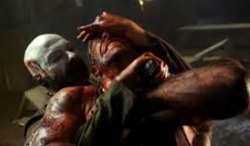 Nine months later, John awakes from his coma and tries to piece together the tattered strands of his life — not an easy task when a sleeper-agent soldier in plumber disguise (UFC fighter Andrei Arlovski) is activated to kill you. (Their post-car-chase tussle in a sporting goods store proves a highlight.) Meanwhile, Deveraux leads an underground movement to “free” these soldiers of their government-implanted memories. That’s a rather dull-sounding subplot, which could be why Hyams has cooked it up in a weirdo marinade flavored with liberal scrubs of The Manchurian Candidate, Apocalypse Now and that one time you “accidentally” licked a toad.
Nine months later, John awakes from his coma and tries to piece together the tattered strands of his life — not an easy task when a sleeper-agent soldier in plumber disguise (UFC fighter Andrei Arlovski) is activated to kill you. (Their post-car-chase tussle in a sporting goods store proves a highlight.) Meanwhile, Deveraux leads an underground movement to “free” these soldiers of their government-implanted memories. That’s a rather dull-sounding subplot, which could be why Hyams has cooked it up in a weirdo marinade flavored with liberal scrubs of The Manchurian Candidate, Apocalypse Now and that one time you “accidentally” licked a toad.

 Written, directed and produced by some guy named David Schwartz,
Written, directed and produced by some guy named David Schwartz,  “All women are the same! They all deserve to die!” Sam screams, which is all the movie allows in way of motivation and plot. Still clad in tie and slacks, he’s going to exact his revenge on the female species, one slut at a time … in broad daylight along highly trafficked areas. Said plan begins when he spots a hooker (“There’s one!”) and picks her up. Some guy drives by and flips them off; she wonders why. “Oh, I don’t know,” he bellows bitterly, “maybe he doesn’t like daytime whores!”
“All women are the same! They all deserve to die!” Sam screams, which is all the movie allows in way of motivation and plot. Still clad in tie and slacks, he’s going to exact his revenge on the female species, one slut at a time … in broad daylight along highly trafficked areas. Said plan begins when he spots a hooker (“There’s one!”) and picks her up. Some guy drives by and flips them off; she wonders why. “Oh, I don’t know,” he bellows bitterly, “maybe he doesn’t like daytime whores!” His thirst for blood finally takes him to a home of one of the Beautiful Ladies of Oil Wrestling (that’s B.L.O.W. for short; subtle, this film is not), where the not-at-all-beautiful, not-true-ladies have gathered this night to scarf down sausage pizza and watch themselves on TV. But first, the frizzy haired girls — christened with monikers like Bambi, Cherry Blossom and Tuff Tiff — all try on bikinis that the most horse-faced of the bunch brought back from New York, because apparently, in a town where prostitution and gambling are perfectly legal, garish swimwear must not be.
His thirst for blood finally takes him to a home of one of the Beautiful Ladies of Oil Wrestling (that’s B.L.O.W. for short; subtle, this film is not), where the not-at-all-beautiful, not-true-ladies have gathered this night to scarf down sausage pizza and watch themselves on TV. But first, the frizzy haired girls — christened with monikers like Bambi, Cherry Blossom and Tuff Tiff — all try on bikinis that the most horse-faced of the bunch brought back from New York, because apparently, in a town where prostitution and gambling are perfectly legal, garish swimwear must not be.  Finally, after offing a nosy neighbor with a shovel, Sam bursts in and has his way with each of the smoky chicks, and that means tying them up and drilling a head or pulling out an arm here and there. After tying up one of the girls in the bathtub, he asks what she does for a living. She responds meekly and with no sense of irony (or any semblance of emotion, really), “I’m a professional oil wrestler and also a TV star.” This sends him into a psychotic rage — “Ruthie loved oil wrestling!” — and he stabs her.
Finally, after offing a nosy neighbor with a shovel, Sam bursts in and has his way with each of the smoky chicks, and that means tying them up and drilling a head or pulling out an arm here and there. After tying up one of the girls in the bathtub, he asks what she does for a living. She responds meekly and with no sense of irony (or any semblance of emotion, really), “I’m a professional oil wrestler and also a TV star.” This sends him into a psychotic rage — “Ruthie loved oil wrestling!” — and he stabs her.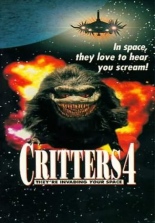
 Those toothy, rolling fuzzballs are back … and in space! Although they did the galaxy-quest thing well before
Those toothy, rolling fuzzballs are back … and in space! Although they did the galaxy-quest thing well before 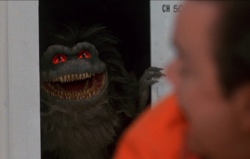 Directed by Rupert Harvey — who produced the
Directed by Rupert Harvey — who produced the 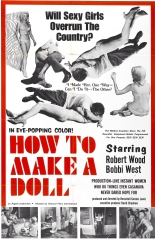
 To say professor Percy Corly (Robert Wood,
To say professor Percy Corly (Robert Wood,  There’s hope for Corly’s virginity yet, when colleague Dr. West (Jim Vance,
There’s hope for Corly’s virginity yet, when colleague Dr. West (Jim Vance, 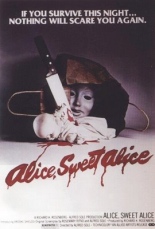
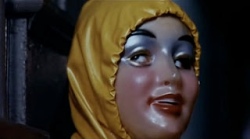 Police detectives, one of whom has an office decorated with pages torn from nudie mags, investigate the crime — or crimes plural, as Karen is merely victim No. 1 in a string of attacks, the next of which takes place on a stairway. This sequence is well-executed (no pun intended) by director/co-writer Alfred Sole (
Police detectives, one of whom has an office decorated with pages torn from nudie mags, investigate the crime — or crimes plural, as Karen is merely victim No. 1 in a string of attacks, the next of which takes place on a stairway. This sequence is well-executed (no pun intended) by director/co-writer Alfred Sole (